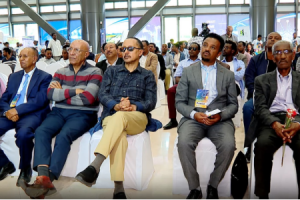
In the vibrant heart of Ethiopia’s capital, Addis Ababa lies Kazanchis, a historic village where several international hotels once stood in stark contrast to rows of shanty houses.
Recently, following government’s aggressive efforts to revitalize shanty areas under the Corridor Development Project, magnificent changes are underway not only in Addis but also in other urban centers across the country. Addis Ababa, which is the seat for several international and regional organizations, is the focal point of these efforts, witnessing amazing transformations not only in infrastructure and urban design but also in enhanced public transportation systems, sustainable environmental initiatives, and environmental sustainability initiatives.
Kazanchis is one among those prominent villages that witnessed urban renaissance. The areas that were once over-looked and neglected have now emerged as symbols of renewal, blending modernity with cultural heritage and becoming one of the most attractive destinations for both local and foreign residents.
As indicated by Prime Minister Abiy Ahmed (PhD) during the inauguration ceremony, the stark contrast between its previous slum areas and the current modernized urban center, the corridor project and Kazanchi`s transformation is a national pride and a powerful indicator for future development.
“Just a few months ago, the appearance of Kazanchis was vastly different from what we see today. It was unsuitable for living, filthy and unsanitary,” the PM remarked.
Certainly, once described as a village with a beautiful name but an ‘ugly identity’, Kazanchis was marked by makeshift houses and a lack of proper amenities. The stark contrast between its bustling streets, disordered residential areas and the poor living conditions of its residents left many shocked. However, now, Kazanchis has undergone a dramatic transformation, becoming one of the city’s most promising destinations for both locals and visitors.
As one of the oldest villages in the capital, Kazanchis was once home to a mix of business centers, luxuries hotels and disordered residential areas. It was also a place where that was suffered from a lack of adequate amenities and urban decay. However, following the efforts made by the government, Kazanchis has now been revitalized into a vibrant urban center that invites exploration and instills a sense of community pride.
As reflected by several residents and government officials, the recent Corridor Development Project, spearheaded by the government not only enhances the physical landscape of Kazanchis but also elevates the quality of life for its residents.
Solomon Mulugeta is a Founder and Managing Director of Eshururu Training Center. He also has a deep-rooted connection to Kazanchis.
Reflecting on its past, he said, “Before the transformation, Kazanchis was pictured by shanty houses and poorly structured buildings that marred the true essence of Addis Ababa.” He believes that the recent changes have dramatically improved not only the aesthetic appeal of the neighborhood but also its overall functionality.
Solomon emphasized the strategic importance of the area mentioning its proximity to international hotels and the National Palace. He suggested that Kazanchis should reflect the beauty and prestigious associated with these landmarks. “It is imperative that Kazanchis must win the expectations of visitors and residents alike. The recent developments have elevated its status, making it a vital part of Addis Ababa’s landscape.”
The transformation of Kazanchis speaks volumes about the commitment and decisiveness of the government to building a smart city that actively combats poverty and promotes inclusivity. Solomon lauded the relentless efforts of government leaders and stakeholders who have dedicated their time and energy to realize this vision.
He remarked, “Transforming Kazanchis is an indicative of our leaders’ commitment to urban development. It reinforces the notion that we can create spaces of beauty and accessibility, driving socioeconomic improvement.”
Kazanchis’s revitalization aligns with the city’s larger goals of improving urban infrastructure to accommodate its growing population and increasing tourism. More parks, better transportation systems, and enhanced security will help foster a sense of belonging among locals.
In discussing the crucial role of urban development, Solomon noted that transformation begins at the individual level. He stated, “Urban development starts in the minds of individuals who aspire to see a better city. Those who are willing to make sacrifices for their community are the ones who will drive change.”
He contrasted this with those who focus on the negatives, stating that a mindset attuned to pessimism can hinder progress. According to him, the solution lies in effective leadership that inspires the masses to appreciate their surroundings and work toward improvement.
Drawing inspiration from international success stories, Solomon referenced Singapore, a nation once lacking diverse tourist attractions, but has now flourished because of strong governance and community-backed initiatives. “Singapore has successfully transformed into a thriving tourist destination, proving that with good leadership and public commitment, significant change is possible,” he said.
Kazanchis, situated in close proximity to the Palace and numerous international organizations, stands at the forefront of Addis Ababa’s future development. As the city aspires to position itself as commercial and tourism hub in East Africa, neighborhoods like Kazanchis must reflect the urban vibrancy and hospitality that wins visitors’ expectations.
To sustain this momentum, Solomon emphasized the need for ongoing engagement with community members and stakeholders. “People must remain active and actively participate in the development process and take responsibility in maintaining the infrastructure that has been put in place,” he explained. “This responsibility cannot fall solely on the government; everyone has a role to play.”
As Addis Ababa takes strides toward becoming a smart city and an attractive destination for tourists, Kazanchis serves as a shining model of what is possible when visionary leadership, community involvement, and unwavering dedication align. The lessons learned from Kazanchis can resonate throughout the city and beyond, proving that even the most neglected areas can rise and reclaim their identity.
With every new parks and renovated streets, Kazanchis is not just changing its appearance—it is rejuvenating its spirit in a way that invites people to explore, engage, and find a sense of belonging. Amidst the backdrop of Ethiopia’s rich cultural heritage and vibrant community life, the renewed Kazanchis stands as a testament to the possibilities of urban revival.
As the village settles into this new chapter, the hope is that its transformation will inspire communities not only in Addis Ababa but also across the country to pursue their own journeys of renewal and development in the coming years. The resurrection of Kazanchis is more than just a physical change; equally, it represents the enduring spirit of a community that is ready to embrace its future.
BY LEULSEGED WORKU
THE ETHIOPIAN HERALD FRIDAY 2 MAY 2025





